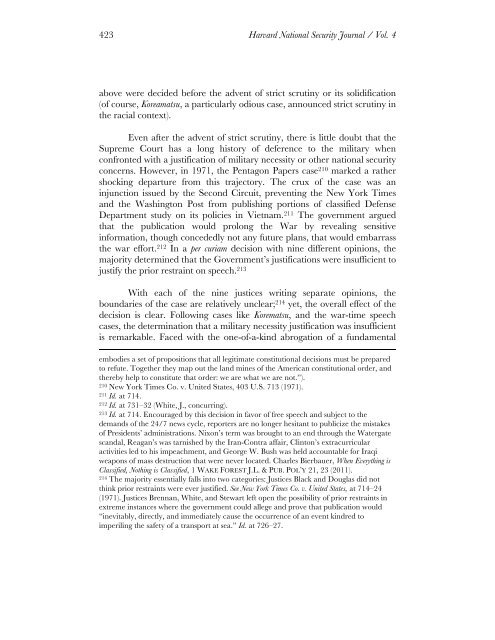Vo.4-Moshirnia-Final
Vo.4-Moshirnia-Final
Vo.4-Moshirnia-Final
You also want an ePaper? Increase the reach of your titles
YUMPU automatically turns print PDFs into web optimized ePapers that Google loves.
423 Harvard National Security Journal / Vol. 4<br />
above were decided before the advent of strict scrutiny or its solidification<br />
(of course, Koreamatsu, a particularly odious case, announced strict scrutiny in<br />
the racial context).<br />
Even after the advent of strict scrutiny, there is little doubt that the<br />
Supreme Court has a long history of deference to the military when<br />
confronted with a justification of military necessity or other national security<br />
concerns. However, in 1971, the Pentagon Papers case 210 marked a rather<br />
shocking departure from this trajectory. The crux of the case was an<br />
injunction issued by the Second Circuit, preventing the New York Times<br />
and the Washington Post from publishing portions of classified Defense<br />
Department study on its policies in Vietnam. 211 The government argued<br />
that the publication would prolong the War by revealing sensitive<br />
information, though concededly not any future plans, that would embarrass<br />
the war effort. 212 In a per curiam decision with nine different opinions, the<br />
majority determined that the Government’s justifications were insufficient to<br />
justify the prior restraint on speech. 213<br />
With each of the nine justices writing separate opinions, the<br />
boundaries of the case are relatively unclear; 214 yet, the overall effect of the<br />
decision is clear. Following cases like Korematsu, and the war-time speech<br />
cases, the determination that a military necessity justification was insufficient<br />
is remarkable. Faced with the one-of-a-kind abrogation of a fundamental<br />
embodies a set of propositions that all legitimate constitutional decisions must be prepared<br />
to refute. Together they map out the land mines of the American constitutional order, and<br />
thereby help to constitute that order: we are what we are not.”).<br />
210 New York Times Co. v. United States, 403 U.S. 713 (1971).<br />
211 Id. at 714.<br />
212 Id. at 731–32 (White, J., concurring).<br />
213 Id. at 714. Encouraged by this decision in favor of free speech and subject to the<br />
demands of the 24/7 news cycle, reporters are no longer hesitant to publicize the mistakes<br />
of Presidents’ administrations. Nixon’s term was brought to an end through the Watergate<br />
scandal, Reagan’s was tarnished by the Iran-Contra affair, Clinton’s extracurricular<br />
activities led to his impeachment, and George W. Bush was held accountable for Iraqi<br />
weapons of mass destruction that were never located. Charles Bierbauer, When Everything is<br />
Classified, Nothing is Classified, 1 WAKE FOREST J.L. & PUB. POL’Y 21, 23 (2011).<br />
214 The majority essentially falls into two categories: Justices Black and Douglas did not<br />
think prior restraints were ever justified. See New York Times Co. v. United States, at 714–24<br />
(1971). Justices Brennan, White, and Stewart left open the possibility of prior restraints in<br />
extreme instances where the government could allege and prove that publication would<br />
“inevitably, directly, and immediately cause the occurrence of an event kindred to<br />
imperiling the safety of a transport at sea.” Id. at 726–27.
















